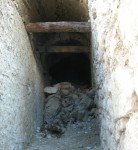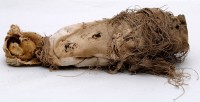 The earthquake that struck the central Italian city of L’Aquila on April 6th, 2009, also devastated the small town of Casentino 10 miles to the southeast. The church of St. John the Evangelist, a masonry structure largely built in the 18th century, was heavily damaged. The apse, the vault over the altar, collapsed, reducing the floor to rubble and exposing a long corridor leading to an underground room. When the firefighters arrived to clear the rubble, they found the remains of 150 people, about 30 of them naturally mummified and about 10 of those exceptionally well-preserved.
The earthquake that struck the central Italian city of L’Aquila on April 6th, 2009, also devastated the small town of Casentino 10 miles to the southeast. The church of St. John the Evangelist, a masonry structure largely built in the 18th century, was heavily damaged. The apse, the vault over the altar, collapsed, reducing the floor to rubble and exposing a long corridor leading to an underground room. When the firefighters arrived to clear the rubble, they found the remains of 150 people, about 30 of them naturally mummified and about 10 of those exceptionally well-preserved.
The find came as little surprise to the residents of Casentino, since the little village didn’t even have a dedicated cemetery until the 20th century; before then people were regularly buried in the ossuary under the church. Over the years the bone pile grew enough to be visible through a lancet window on the back of the church. They didn’t know there were natural mummies in excellent condition, however.
Since the needs of earthquake cleanup and repair took priority, the remains were moved to a protected area of the church for later retrieval. It was two years before experts from the cultural patrimony ministry and archaeological superintendence were able to remove the 10 or so mummified remains in the best condition to the superintendence’s headquarters in Chieti. There they could be preserved in ideal climactic conditions and studied by the anthropology department of the University of Chieti. The rest of the remains were reinterred in the church.
This Italian language news story has some good views of the damaged church and some of the mummies:
[youtube=http://youtu.be/fiBFxl07c4Q&w=430]
Archaeologists studied the clothing and human remains in the hope of learning more about how people lived and died in this small countryside hamlet. Their clothes were in the French style of the Napoleonic era, but upon closer examination the deceased were found to date to different periods over a 200 year range, at least some of the victims of a documented plague in the 1800s. Textiles, shoes, corsets, skirts, shirts, shrouds, rings and rosary beads can be dated by their materials and styles to the 19th century or earlier. People of all sexes and ages are represented: women, men, children, the elderly and even one fetus.
Anthropological examination found an unusually high number of bodies bore evidence of having been autopsied. Dissected skulls (craniotomy) and ribs (costotomy) were particularly common. This wouldn’t be so incongruous in, say, a university city, but in a little country village it’s practically unheard of. There must have been a very curious physician practicing in the area.
 It’s the fetal mummy that proved the most startling. Researchers were able to radiocarbon date the shroud wrapping the tiny mummy and found that it was buried around 1840. The fetus died around 29 weeks of pregnancy, so small that sex determination from the bones was not possible. An X-ray of the mummy bundle found the skeleton was not articulated. The skull was dissected in several places and separated from the neck. The arm bones were removed from the skeleton and dislocated at various joints.
It’s the fetal mummy that proved the most startling. Researchers were able to radiocarbon date the shroud wrapping the tiny mummy and found that it was buried around 1840. The fetus died around 29 weeks of pregnancy, so small that sex determination from the bones was not possible. An X-ray of the mummy bundle found the skeleton was not articulated. The skull was dissected in several places and separated from the neck. The arm bones were removed from the skeleton and dislocated at various joints.
This disarticulation is different from the autopsies found in the other mummies from the site. It appears to have been done in utero, not outside of the mother’s body.
All of these characteristics “strongly suggest a case of embryotomy,” which was a procedure that occurred before removing the fetus from the womb, study author Ruggero D’Anastasio of University Museum at University of Chieti, Italy, told Live Science.
This likely case of embryotomy “is the only anthropological proof of this surgical practice up to now in this geographical region,” he added.
Embryotomy was a common practice in ancient times, D’Anastasio said. The procedure was practiced in Alexandria and then in Rome during the first and second centuries, the researchers wrote in the study. Physicians typically performed it when a mother’s life was threatened due to delivery complications or when the fetus was already thought to be dead in the womb.
The little fellow was buried with the utmost care, all the body parts placed back together in the proper anatomical placement and then clothed. The skull fragment was placed on top of the mummy’s head and covered with a little cap.
The concluding paragraph of the study report in the International Journal of Osteoarchaeology:
In summary, our report provides evidence for what is likely the best example of embryotomy in the archaeological record of Italy. It also demonstrates that the praxis specialised in gynecology was surprisingly diffused into a very little and peripheral village in Central Italy, where evidently physicians with high degree of professionalism worked. By contrast, the recomposition of the cut-up body and its perfect dressing indicate high sense of pity for the death and for children never born.